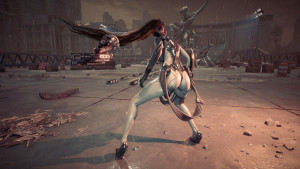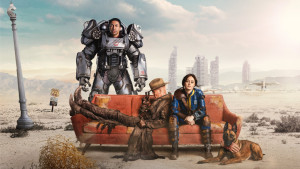Please support Game Informer. Print magazine subscriptions are less than $2 per issue
Xenoblade Chronicles 2
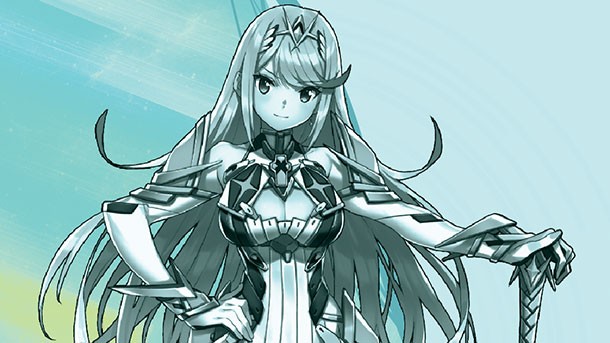
Since finishing up the Xenosaga trilogy, Monolith Soft has been reimagining the JRPG for modern gamers exclusively on Nintendo's consoles. The original Xenoblade Chronicles garnered plenty of fanfare and critical acclaim for its creative design and MMO-style combat. Its follow-up on Wii U, Xenoblade Chronicles X, didn't hit as high of a bar, but still showcased Monolith's knack for creating fun worlds. Now Monolith is going back to its roots with a more story-focused adventure that retains X's sense of discovery.
Xenoblade Chronicles 2 is one of the first big RPGs hitting Switch, a fast-selling platform still yearning for more exclusives. For a game so close to its launch date, Nintendo has been dishing out details slowly, leaving fans unsure of what to expect.
After spending four hours of hands-on time and chatting with its developers, we have a better understanding of what Xenoblade Chronicles 2 offers in terms of combat, characters, and exploration. Get ready to journey across colossal beasts and customize your party by discovering new Blades, all while seeking out the ultimate paradise for humanity.

Protecting A Blade
While Xenoblade Chronicles 2 is technically the third game in the series, it's the one earning the rightful title of a sequel.
"Xenoblade Chronicles X was a game really focused on exploring and [having an] open world and [defeating] monsters," explains executive director Tetsuya Takahashi. "When we thought about starting to develop the next game, I wanted to go back to a more story-driven design. And so in that sense, this focus on a story-driven game is kind of the legacy of Xenoblade Chronicles 1, so we decided to kind of make it the next iteration of that."
Xenoblade Chronicles 2 fits within the series' universe, but the team didn't want to just rehash what it had already done. Therefore, it crafted a brand-new narrative and characters alongside a revamped combat system complete with the depth and customization the series is known for, connecting its story and combat with the concept of Blades. In this world, you have characters who are "Drivers" and those who are "Blades." Blades imbue Drivers with specific weapons, such as axes and swords, granting special abilities in combat. Every Blade has special attacks that center on an elemental affinity. This all ties into your battle strategy (more on that later).
The story revolves around a world of endless clouds named Alrest, a Driver named Rex, and a Blade named Pyra. At the start of the game, Rex is just an independent salvager, but when he crosses paths with Pyra, he feels compelled to help her, as Pyra is not your typical Blade. She's the Aegis, which means she's capable of absolute destructive power. This drives a mysterious group called Torna to try and manipulate her for their own selfish means. Tired of being sought after by so many vicious people, Pyra wants to escape and go back to her home, Elysium, which is also known as paradise for humanity. No one knows if this fabled land actually exists, but it's said to be the key to everyone's survival. "We [wanted] to make it into kind of a young man's adventure," Takahashi says. "It's kind of lighthearted – there's a lot of discoveries to be made, so we made it almost like an anime you would watch. But you know the kind of person that I am; the story does get a little bit heavier, a little bit darker. If you expect the same kind of evolution from the story that you would expect from a Xenoblade game, you're probably on the right track."
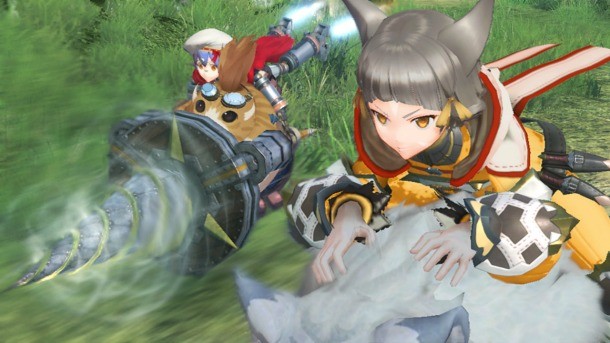
Your main goal in Xenoblade Chronicles 2 is to find Elysium, but it's not an easy task with everyone hunting you down while the world is embroiled in political turmoil. Many powers rule over different regions of Alrest, and each differ in how they coexist with their Titans. Having a deep respect for nature, the Kingdom of Uraya boasts advanced bio-technology, for example. In contrast is their rival, the Empire of Mor Adain. Controlling their Titans mechanically, the militaristic Empire packs heavy armaments for protection against potential threats.
Rex and Pyra meet other Drivers and their Blades as they navigate these regions. From the tech-savvy Tora, who creates his own robotic Blade named Poppi, to Nia, a hothead with a mysterious past and a regal Blade named Dromarch, every party member you encounter offers great (and much needed) assistance on your quest.
| A New Art Style |
| Xenoblade Chronicles 2 boasts a more youthful art style, looking closer to anime. It was a change Monolith felt would help make their characters come alive better. “We felt that in Xenoblade Chronicles 1 and X, the facial expressions [were] kind of a little bit hard, a little bit stiff,” says executive director Tetsuya Takahashi. “We really wanted to put a little bit more focus on creating facial expressions and for the characters to be more expressive, and so that's why we went with the direction we did, which I guess you could say is a little bit leaning toward something like Japanese animation.” |
In many ways, Xenoblade Chronicles 2 focuses on what worked so well in the first game – providing a sense of purpose with the story. Unlike X, where you wandered around aimlessly for your next objective, Xenoblade Chronicles 2 gives you more direction and a direct connection to its characters and their plight.
This may technically be a sequel, but don't expect obvious nods to the first game. "It's completely different in terms of place, time, and space," Takahashi says. "Obviously I can't divulge all the details, but if you play the game, I think you'll get why this is called Xenoblade Chronicles 2."
This approach doesn't count out references to Takahashi's previous work on Xenogears or Xenosaga. "There's a lot that I can't talk about yet [that] hasn't been revealed, but it will be hopefully soon," Takahashi teases. "I think there's content in there where longtime fans of the series will have a pleasant surprise."
Click to the next page to learn all about the new combat...

A New Way To Fight
During my hands-on time, the biggest revelation is the complexity of the new battle system. You can have three Drivers in your party at once, and each has the ability to equip three different Blades they can swap to on the fly. Your Drivers are assigned roles based on the types of Blades you equip, such as healer, attack, or tank, similar to the first game. You receive bonuses depending on your class, which can boost damage and healing or provide other benefits.
You only control one character on the battlefield, but aren't locked to Rex. Once you initiate battle, your character auto-attacks enemies in range using your active Blade's weapon. Auto-attacks build up a meter, and once filled, you can unleash the Blade's stronger abilities called Arts. Arts are not only powerful, but can also inflict status effects. Some Arts also factor in positioning, meaning if you strike the enemy from the side or back, you can increase the damage dealt. You can equip three arts at once per Blade, and these can be leveled up, allowing you to maximize your favorites.
As the master strategist, you decide what Blades and Arts to use, assuming they're not on cooldown. Although your Driver auto-attacks, battles still get frantic with button prompts to unleash devastating Art combos. You can cancel an incoming attack by using an Art right when your weapon finishes its combo. For instance, with Rex I anticipated the end of his three-move combo and then struck the Art immediately to block the incoming attack. Canceling quickly charges up your special meter, so it's in your best interest to perform it when you can.

The window of opportunity is slim on combos and canceling, so you must pay close attention to get the most out of combat. Pulling off combos can easily turn the tides of a tricky fight. Having trouble taking down an enemy? Not a problem. One character can inflict Break on the opponent, and another character can follow-up with Topple. This gives you a short time in which your enemy is defenseless, and you can then unleash your most powerful Arts. A combo like this should be familiar to returning players of the Xenoblade Chronicles games and shows that while there's the new introduction of the Blades mechanic, the combat is evolved from the previous entries.
| Deep Sky Diving |
| Get ready to dive into an ocean of clouds. In Xenoblade Chronicles 2, Rex has the ability to dive through the clouds and score big treasures. To do so, he must purchase a cylinder, which is a tank that allows you to dive. By hitting buttons at opportune moments as Rex runs to dive, you can increase the amount and chances of getting rare items. But beware, Rex can also bring enemies back with him that you must battle. This is a great way to get items and make money. |
The depth doesn't stop there. You also have a multi-level special meter that fills up via your Arts. You can unleash up to four levels of specials, which also inflict an elemental status effect based on the element of the Blade. Then there are Blades combos – to perform these, you must inflict the elemental affinity specified on screen in order to get to the next level. Your party members help out with this. You might unlock level one with a wind attack, while to get to level two, you need to use an earth attack that your teammate has on hand, and so forth. These combos can result in extremely powerful attacks that have a variety of effects against your foes, such as preventing them from using their abilities and even their own Blades.
If Monolith learned anything from X, it's that people still enjoy finding those hard-to-take-down baddies that require you to pull out all stops. On top of Blade combos, you can go a step further with chain attacks, which are vital to taking down these larger bosses. To initiate a chain attack, you must fill your party meter by performing attacks and Arts. Once executed, each Driver takes a turn attacking the enemy with a powered-up level one special.
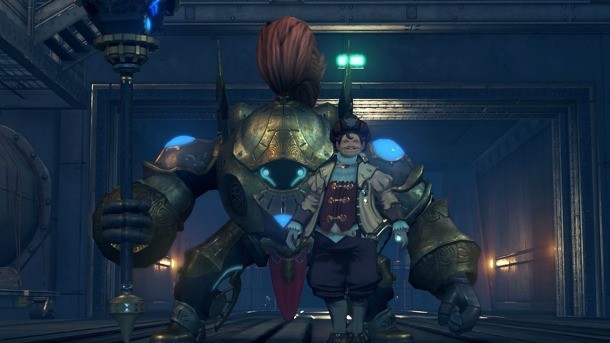
Elemental orbs also appear on the enemy from performing Blade combos, and you can burst them by attacking them with their opposite element. You have three chances to break one of these orbs and if you do, your three active Drivers get to take another shot with their powered-up special. Keep timing your attacks right, and your attack power keeps increasing, allowing you to do crazy damage. It gets extremely satisfying when it all comes together.
These layers to the battle system are a lot to take in, and I felt overwhelmed at first, but the game introduces you to everything gradually. Once you learn the ropes, it becomes second nature. It can be frustrating missing a cool combo because you don't have the right element or your timing is just a tad too late, but missing the higher combos won't hinder you during regular battles. I liked what I played of the battle system, because it feels like you're constantly getting new strategies and Arts by finding new Blades with different weapons and element types.
Monolith says it spent a lot of time thinking about how to revamp the control scheme, and it shows. The controls are also smooth and a lot more direct than past games, which were very menu-heavy. Everything revolves around simple button presses. Now you can use the Arts tied to your weapon simply by pressing the corresponding button on the right Joy-Con. The buttons on the left Joy-Con match up with your blades, allowing you to switch weapons in a jiffy to adapt to situations. "In terms of the UI, this game is on a new console, and so we wanted to make sure it matches that hardware," Takahashi says. "We felt that the way we have it now, it makes it a lot more instinctual – it's very natural. And the Switch is also portable, and since you can take it anywhere you want, we made sure the UI is very easy to see, even when you're carrying it around with you."
Click to the next page to learn more about the thrill of discovering Blades...

A World Of Exploration
Exploration has always been a huge part of the Xenoblade series, and that isn't changing. If anything, it's getting even more exciting with the addition of core crystals, which are used to unlock new Blades. Some you collect through the story, while others can be found by doing quests or taking down enemies. Core crystals come in three different tiers: common, rare, or legendary. Nintendo says Xenoblade Chronicles 2 has no microtransactions, so you won't be buying these crystals with real money. The game has some ways you can increase your chances of getting certain elements by buying boosters with in-game currency, but they don't come cheap. You also can't cheat because the game saves as soon as you open a core crystal, not allowing you to reload if you don't get what you want.
Opening core crystals became one of my favorite things to do. Not only are there some really cool designs and animations (one of my Blades came out bouncing a basketball), but getting a new Blade often brings new abilities and it feels like you hit the jackpot and unlocked massive power when you get something higher than common. "We spent a lot of time on the 3D animation involved in bringing them to life, and probably overall, the work we did on the Blades would be about equal to the time we spent crafting the main story of the game," says producer Koh Kojima.
Kojima also likes the thrill of discovering what's under each Blade's hood. "When you get Blades, sometimes you might get [ones] that you initially don't want, but when you actually start using them, you're like, 'oh, no, this is actually a really useful Blade.' There's this kind of feeling of unexpectedness that happens," he adds.
The customization options with your Blades also feel endless. They change your party dynamic, their weapon type changes your play style (from quick-striking knuckles to lumbering but powerful axes), and you can enhance them. For instance, every Blade has its own ring of achievements, which range from killing a certain number of enemies to giving your Blade its favorite food. Completing all those achievements earns you different special effects, such as upping your chances of blocking an attack by 70 percent or increasing aerial damage by 60 percent.
Defeating enemies produces aux cores, crafting materials that are used to upgrade your Blades. You use aux cores to create enhancements for your Blades to give them different perks, such as critical up and reflect damage. Blades can equip three of these enhancements at a time.
| Upgrading Poppi |
| Poppi is an artificial Blade, so you can’t improve her abilities the way you would other Blades. She still has an affinity chart and weapon modification, but you must create special core chips to maximize her output. You can purchase these chips by collecting gems that are only available by playing an arcade game called Tiger! Tiger! In it, you deep-sea dive and excavate jewels, trying to avoid enemies and obstacles. You have a limited amount of air and must grab as much treasure and bring it back up before you run out. Enemies can be taken out in different ways with your excavation tool, such as a turtle who needs to be hit from underneath to jellyfish needing to be hit on top of their head. “Off the bat, we wanted to have a different type of gameplay experience with Poppi, so we decided to put in a minigame,” says executive director Tetsuya Takahashi. “The concept is kind of taken from ’70s arcade games – that's the kind of vibe and atmosphere we wanted to create.” Takahashi hinted that it’s in your best interest to spend the time to level up Poppi. |

One feature that is sure to come in handy is merch missions. You can easily level up Blades when they're not in your party by sending them on these quests. This gives them experience points and also grants you new items. In addition, sending a Blade on a merch mission can also increase your chance to complete some of their achievements to unlock aforementioned special effects. The missions take about 30 in-game minutes, but if you have the suggested field skills, it makes it go faster. Another way to improve your Blade quickly without having to grind is by using core chips. Purchasing and finding these can multiply a character's attack damage.
Finding Blades is just one part of the exploration. Monolith dialed back from Xenoblade X in terms of surface area, but that doesn't mean there's not much to do. "Because this game is story-driven, I don't think that an open world is necessarily appropriate," Takahashi explains. "And I feel that we were able to make a game [with a world] that's really appropriate and really supports the story-driven aspect of this game. For example, if you compare it to Xenoblade 1, there's plenty of places [and worlds] to explore; but when you look at simple surface area, it might be a little bit smaller than Xenoblade Chronicles X. Like I mentioned, I don't think that such a vast space is necessary, so instead of focusing on increasing the raw surface area, we thought it was more important to increase the density and pack in as much variety in design [as possible], and for people to be able to enjoy the changing landscape as they traverse and explore this world."
This is no ordinary adventure; you run on the backs and sometimes even the insides of titans that look like giraffes, whales, and humanoids. Expect to also face all kinds of harsh weather, from frozen landscapes to sandstorms affecting your visibility.
As the series is known for, Xenoblade 2 has its share of side quests. I saw tons of NPCs with quest markers and notice boards in every town. The basic fetch quests are still there, but the game also has its share that add to the story. You can even unlock some of the rare Blades and learn more about them through side quests. "They're more directly related to their story, and you get to learn about their quirky characteristics [and] their personality traits that they have," Takahashi says. "There's also a lot of subquests that kind of branch off of the main storyline in that there might be a character that only has a small role in the main story, but if you chase that down, you get to learn more about this character and more about who they are."

The Long Road Ahead
Monolith is still dedicated to providing a lengthy RPG. Xenoblade Chronicles 2 has only 10 chapters, and when I was brought into chapter four we were only around the 45-hour mark. "As you may or may not have expected, the playtime required to beat this game is a little on the high side," Takahashi says. "If you just play the mainline story, there's still enough to probably be comparable to Xenoblade 1, but like in past Xeno series, if you are just playing the main story, there might be times where you encounter a boss or an enemy that's actually a little bit too tough or very tough for you to beat. I strongly recommend taking side roads, taking the time to explore different areas, defeating monsters, picking up items, leveling your character up, [and] doing quests."
Time will tell if Xenoblade 2 can surpass its predecessors, but so far it looks promising, with Monolith taking the best elements from its last two entries and packing them into a more contained, story-driven experience. Hopefully, as a December release, it can make waves late in the year and give Switch owners a new big RPG to sink their teeth into.
As for the future, Monolith is already planning. "Moving forward, if we do another story-driven Xenoblade game, I was thinking I'd like to keep the numbering going," Takahashi says. "Now that we've gone through the process of development, we're in a spot now where I'm beginning to think about what we want to do next," Kojima adds. "We'll really be keeping our ears to the ground to see what fans are wanting, what they're looking forward to. We've enjoyed this collaboration with Nintendo so far. We really are thinking about where to go next, and that's where I'm at right now."










